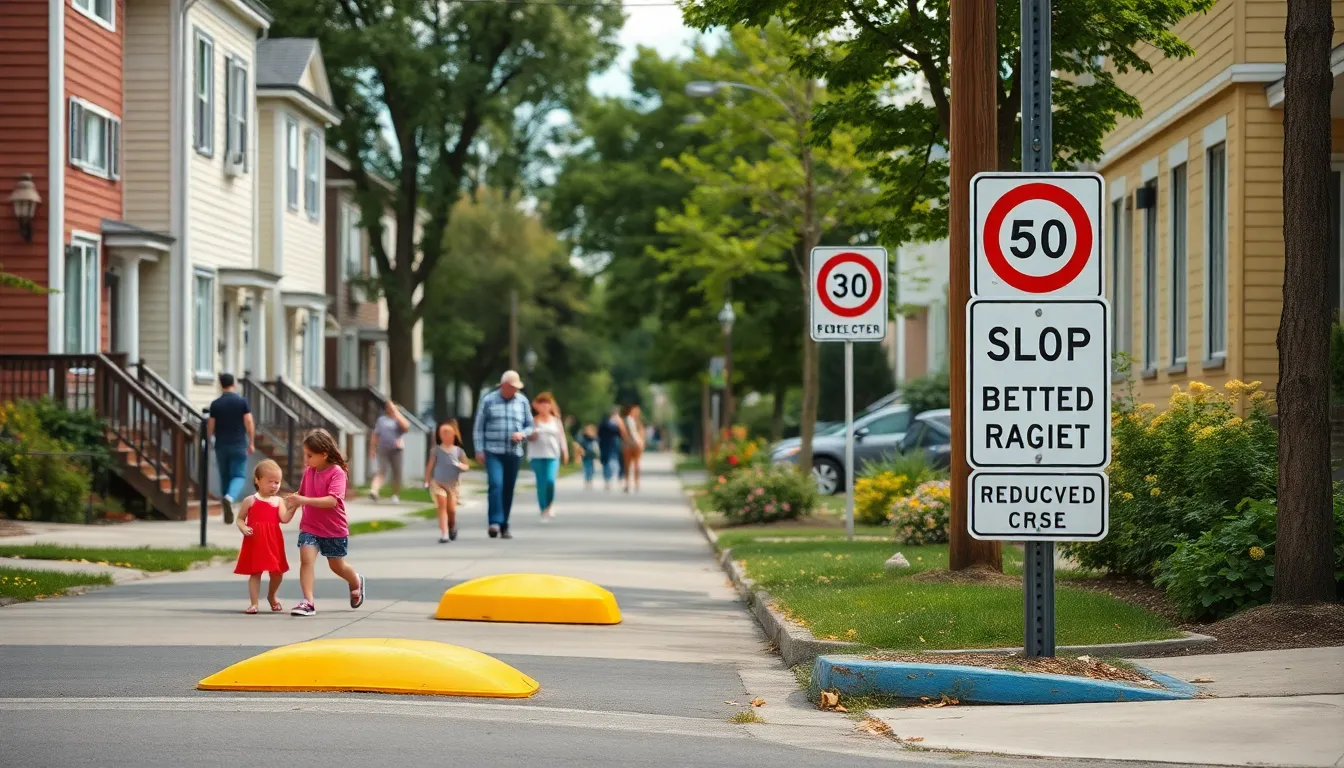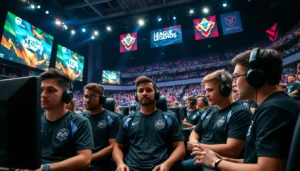Table of Contents
ToggleIn a world where speed limits often feel like mere suggestions, slow zone enforcement is the unsung hero of road safety. Picture this: a serene neighborhood, kids playing, and a driver zipping by like they’re late for a rocket launch. Enter slow zone enforcement, the friendly neighborhood traffic cop that’s here to remind everyone that life’s too short to rush through the local park.
Overview of Slow Zone Enforcement
Slow zone enforcement plays a critical role in enhancing road safety, particularly in residential areas where children play. This initiative addresses the pressing need to deter reckless driving and promote more cautious driving behavior. Communities implementing slow zone enforcement witness significant reductions in speeding incidents.
Effective enforcement mechanisms include speed bumps, signage, and traffic cameras that monitor vehicle speeds. These tools work together to create a safer environment for all residents. Speeding vehicles pose a significant risk, leading to injuries or fatalities. By establishing designated slow zones, neighborhoods cultivate safer spaces for pedestrians and cyclists.
Data shows that areas with slow zone enforcement experience reduced traffic accidents. According to a study by the National Highway Traffic Safety Administration, areas with lower speed limits report an average decline of 30% in crash-related injuries. Drivers often adjust their behaviors when they encounter well-marked slow zones, fostering a sense of accountability.
Community engagement plays a vital role in the success of slow zone initiatives. Residents advocating for the enforcement contribute to heightened awareness about road safety. Collaboration between local governments, law enforcement, and community members is essential to maintain safe streets.
Consistency in enforcement strengthens the impact of slow zone regulations. Regular monitoring ensures that speed limits are respected. Moreover, educational campaigns inform drivers of the importance of adhering to speed limits, amplifying the overall effectiveness.
Promoting slow zone enforcement also aligns with broader public safety goals. Prioritizing the safety of residents leads to an improved quality of life in neighborhoods. Community cohesion thrives when everyone feels safe in their environment.
Importance of Slow Zone Enforcement

Slow zone enforcement plays a crucial role in maintaining safe neighborhoods. These measures prioritize the protection of residents, especially children who play on streets.
Enhancing Road Safety
Enhancing road safety occurs through reduced speed limits in key areas. Speed bumps and clear signage alert drivers, reminding them to slow down. Effective implementation leads to a significant decrease in accidents, with studies showing a 30% reduction in crash-related injuries. Neighborhoods where slow zones are enforced benefit from safer streets. Adults and children can navigate their surroundings confidently, knowing drivers adhere to lower speeds.
Reducing Traffic Violations
Reducing traffic violations becomes simplified through established slow zones. Traffic cameras monitor compliance, discouraging reckless driving behavior. Residents report fewer speeding incidents, fostering a sense of community accountability. Local law enforcement can focus on other pressing issues when drivers respect speed limits. Consequently, neighborhoods experience an overall improvement in driving behavior. Increased awareness among motorists contributes to a culture of safety and responsibility.
Strategies for Effective Implementation
Implementing slow zone enforcement requires a combination of technology and community engagement. These strategies enhance road safety and promote compliance among motorists.
Technology Integration
Technology plays a vital role in effective slow zone enforcement. Utilizing speed cameras and sensors allows for real-time monitoring of vehicle speeds. Automated systems capture violations, generating fines that deter reckless driving behavior. Advanced signage provides instant feedback to drivers, alerting them when they exceed speed limits. Integration of mobile applications aids in reporting issues, creating a connected network where residents can engage with local authorities. Data collected from these technologies supports continuous improvement, ensuring that measures adapt to changing conditions and community needs.
Community Involvement
Community involvement is essential for the success of slow zone enforcement. Engaging residents fosters a sense of ownership and responsibility regarding neighborhood safety. Organizing workshops and informational sessions educates the public on the importance of speed regulations. Residents can participate in discussions about proposed changes, ensuring their concerns and suggestions influence decisions. Collaboration with local schools and organizations amplifies awareness, encouraging programs that promote safe driving. Neighborhood watch groups can monitor compliance, reinforcing community standards and improving overall effectiveness.
Challenges in Slow Zone Enforcement
Public resistance often poses a significant challenge to slow zone enforcement. Many residents view new speed limits or traffic measures as restrictions on their driving freedom. Engaging community members through outreach efforts helps address concerns. Clear communication about the benefits of slow zones can shift perceptions. Involving local leaders in discussions encourages collaboration and eases tensions.
Resource limitations present another obstacle to effective enforcement. Financial constraints frequently hamper the installation of necessary infrastructure, such as speed bumps and traffic cameras. Budget allocations may prioritize other projects over slow zone enforcement, diminishing community safety efforts. Despite these challenges, leveraging grants and partnerships can enhance funding opportunities. Utilizing volunteer resources can supplement enforcement initiatives, leading to successful implementation. Addressing these issues with strategic planning strengthens the potential for effective slow zone enforcement.
Case Studies and Success Stories
Brooklyn, New York demonstrates the positive effects of slow zone enforcement. After implementing speed bumps and improving signage in residential areas, the city reported a 40% reduction in speeding violations. Local residents noted an increase in children playing safely in the streets, showing that enforced slow zones significantly enhance community safety.
In Los Angeles, the introduction of automated traffic cameras yielded remarkable results. Following their installation, the city experienced a 35% decrease in traffic accidents in monitored zones. Increased compliance with speed regulations contributed to a cultural shift towards safer driving behaviors among residents.
Seattle’s community engagement model serves as an effective approach to slow zone enforcement. By organizing workshops with schools and neighborhood groups, the city fostered a sense of ownership over local safety initiatives. Engaged participants successfully advocated for additional speed limit signage, which led to a 25% decline in complaints regarding reckless driving.
Toronto also presents a compelling case. The city began using digital road signs that provide real-time speed feedback to drivers. This initiative resulted in a 30% drop in average vehicle speeds within designated slow zones, reinforcing the importance of immediate feedback in altering driver behavior.
Another noteworthy case comes from Chicago, where partnerships with local organizations supported enforcement efforts. Utilizing grants, the city upgraded infrastructure and installed additional traffic calming measures. The result was a 20% reduction in pedestrian injuries, showcasing the effectiveness of collaborative funding strategies.
These examples illustrate the potential success of slow zone enforcement across various cities. Each case reinforces the need for continuous engagement, community involvement, and technology integration in promoting safer road environments.
Slow zone enforcement stands as a vital strategy in enhancing road safety across communities. By prioritizing reduced speed limits and implementing effective measures like speed bumps and traffic cameras, neighborhoods can significantly decrease traffic accidents and injuries. The positive outcomes seen in various cities underscore the importance of community engagement and technological integration in fostering a culture of safety.
While challenges exist, the potential for safer streets is achievable through collaborative efforts and innovative solutions. As communities continue to advocate for and support slow zone initiatives, the overall quality of life improves for residents, ensuring safer environments for children and families alike.




